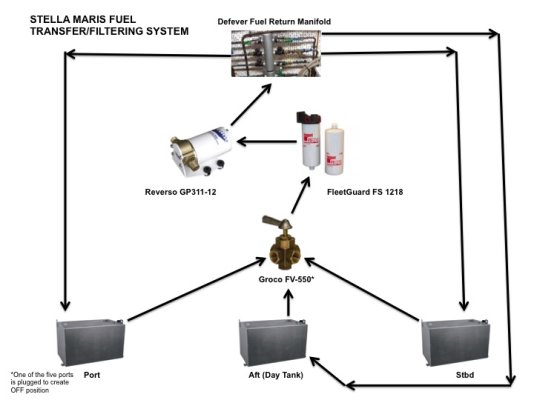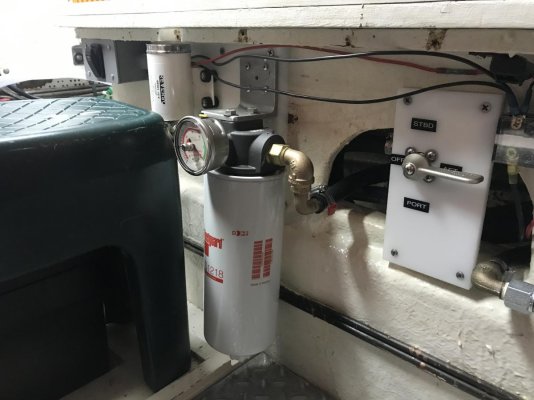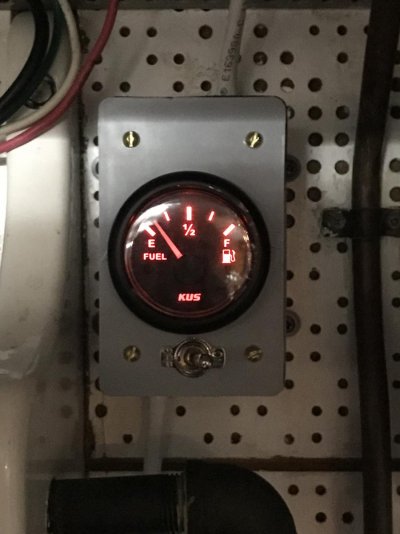Congrats on your new DeFever. If you haven’t already, take a look at DeFever Cruisers, a very active owners group.
The aft tank on our ‘87 Is ~250 gallons. We use it exclusively as a day tank, transferring filtered fuel to it before set out each day. Our saddle tanks are only used for fuel storage. We’ve never been in a situation where we needed to fill all three tanks (~900 gallons). A tank cleaner, as recommended above, can often install an inspection port if you don’t already have one. If there are still doubts, you might find a tank manufacturer or inspection service that will do a pressure test.
The following was my response to Graham on the DeFever Cruisers Forum. Our tank was rusted out on the underside. It was totally beyond retribution.
Our aft tank was decommissioned when we bought her. When I removed the bed platform, I found out why. The aft tank was a rusted out mess. I believe it is because the bottom of the tank conforms to the shape of the hull with about one inch of clearance. Water from the condensation pan of the air conditioner air handler drains underneath the tank to the aft bilge as does water from the rudder packings thus creating a very moist environment with ZERO air movement. I had the tank removed and created long-term storage there by installing a sheet of marine plywood across the stringers. I know of one other DF44 that had and removed a rusted-out tank, Life's Travails.
The aft tank capacity is 235 gallons but you have more than 700 gallons in the side tanks. That gives you at least a 1,000 mile range with a very healthy reserve. Even going to the Bahamas for an extended period, I doubt you would need more than one thousand miles worth of range. Bottom line is, you very likely do not need that aft tank. Plus, if you fill it you will be hauling around 1,500 extra pounds of weight.
You will have to have your refit yard to remove the mattress and the platform on which it rests to inspect the tank. My bet is that it is unserviceable. Our refit yard gave us a firm-fixed price of $10,000 to replace that tank. Instead, they removed it for $2,000, a bargain in my estimation. We did a Great Loop and never came close to running out of fuel.
As far as cleaning out that tank, even it is not rusted out, there is no inspection port on the top surface. Plus the fill hose is not a straight drop into the tank as they are on the side tanks. Therefore, a dockside fuel polishing service would not likely be able to get a pressure wand into the tank to ensure that anything and everything living in there is stirred up and polished out. Here's some more bad news. When our refit yard cut away the top of the tank there were FOUR INCHES of mud on the bottom. From where did this "mud" come? I believe the mud was the dead bodies of diesel eating bugs that thrive when water is in a tank.
Some diesel was still in that tank. It did not leak into the aft bilge because the mud sealed off the holes in the bottom of the tank. Unfortunately, even if you inspect the tank from the top you cannot know what is the condition of the tank on the underside so, if you try to clean the tank and there are holes in the bottom that are now blocked by mud or other gunk, you risk diesel fuel going directly to your aft bilge. You DO NOT want diesel to get into your aft bilge. The only access to the aft bilge on a DF44 is a 12-inch square hatch in the left corner underneath the ladder to the owner's cabin. Cleaning the aft bilge of diesel fuel would not be fun.




